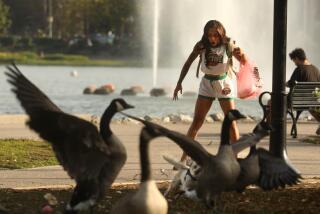Return of the Canada Geese
- Share via
In Southern California, autumn is marked by the return of the Canada geese. Migrating from summer nesting sites in Canada and the Great Basin states, these stately birds cruise their highways in the sky, resting or stopping for the winter in the San Fernando Valley.
Until recently, the number of geese wintering or passing through the Valley could only be estimated. But last year volunteers from the San Fernando Valley chapter of the Audubon Society conducted their first Canada geese count. They determined that about 3,000 geese spent the winter or passed through the county last year.
Canada geese winter in the Valley because of its large, open areas with bodies of water and food sources. Here’s where they congregate: 1. Chatsworth Reservoir (days) 2. Pierce College (days) 3. Encino Reservoir (nights) 4. Sepulveda Basin (days) 5. Van Norman Reservoir (days) Pacific Flyway Migrating geeses fly to their winter homes along established routes called flyways that take them over river valleys and coastal wetlands. Researchers divide flyways into migration corridors, stripes of airspace 30 to 50 miles wide. Migration Most geese that winter here migrate from nesting sites in Utah and Montana, and western Canada. The geese usually arrive with their young in late October and return north in late February or early March. How fast do they fly?: About 45 m.p.h. How high do they fly?: 1,000 to 3,000 feet, sometimes as high as 12,000 feet to avoid mountains. How far do they fly?: About 300 miles a day. They fly day and night, stopping briefly to rest and eat. Why do they migrate: Greater availability of food and longer foraging days improve their young’s chance for survival. How do they navigate?: Experts believe geese use navigational cues such as the landscape, the sun and stars. Great Basin Canada Goose Branta candensis mofftti There are up to 12 subspecies of Canada geese, which differ in physical markings, calls and range. The Western subspecies winters here. Size: Weighs up to 15 pounds, usually 8 to 10 pounds; 35 to 37 inches long, 50-inch wingspread. Markings: Its white cheeks and “chinstrap” distinguish it from other geese. Food: Small sprouting plants, grain, corn. Habitat: Prefers large, open spaces near bodies of water. Breeding: A breeding pair of geese will stay together for life. During breeding season four to seven eggs are laid, which the female incubates for 26 to 28 days. Both mother and father care for young, which accompany their parents during migration. The family stays together for nearly a year. V Formation Geese fly in V formation flocks of extended families numbering a few dozen to several hundred. Birds fly slightly to the side, behind and above the bird in front to take advantage of the lifting of the air currents created by the wingtips of the bird ahead (shown below). Power lost at each bird’s wingtip is salvaged and used by others in the flock. Geese flying in the V formation can fly 71% farther than they could flying alone. Sources: Audubon Society, “The Canada Goose,” by Kit H. Breen; Kimball Garett,Los Angeles County Museum of Natural History. Researched by JULIE SHEER.
More to Read
Sign up for The Wild
We’ll help you find the best places to hike, bike and run, as well as the perfect silent spots for meditation and yoga.
You may occasionally receive promotional content from the Los Angeles Times.






